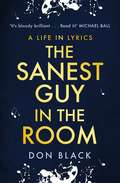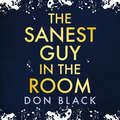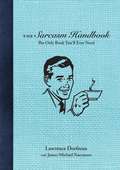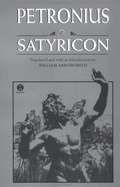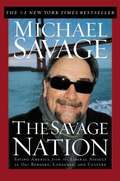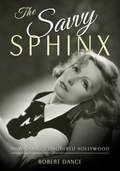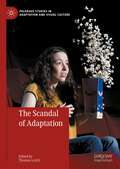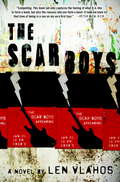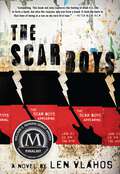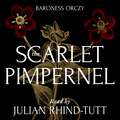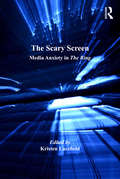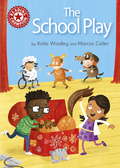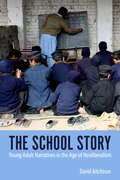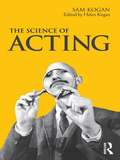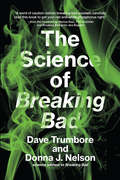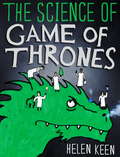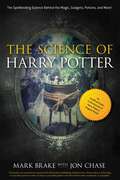- Table View
- List View
The Sanest Guy in the Room: A Life in Lyrics
by Don BlackTHE SUNDAY TIMES BESTSELLER'. . . a compelling memoir. Breezy and unpretentious, The Sanest Guy in the Room is a delightful collection of memories, insider information and after-dinner anecdotes' The Times'Brilliant stories and wonderful behind-the-scenes glimpses of a life and career in show-business . . . It's bloody brilliant . . . Read it!' Michael BallDon Black is the songwriter's songwriter, a composer's dream collaborator, and the man behind some of the twentieth century's greatest musical numbers.Black made his first foray into the glittering world of showbiz as a stand-up, before realising his error and focusing on his lifelong passion instead - music. Shirley Bassey, Michael Jackson, Quincy Jones, Henry Mancini and Barbra Streisand are just some of the artists Black has worked with over the years - not to mention his frequent collaborator, West End legend Andrew Lloyd Webber - in what can only be described as a remarkable musical career. Yet, never one to court fame, Black has always remained what Mark Steyn coined as 'the sanest guy in the room'.Interwoven with the stories behind songs such as 'Diamonds are Forever' and 'Born Free' are vignettes of Black's life with his beloved wife Shirley, who died in March 2018, after almost sixty years of marriage. Black writes movingly about how the enormity of his grief changed his life, and how the dark days are slowly turning into dark moments.The Sanest Guy in the Room is a rich and delightful paean to a life lived through song. It reveals the essence of Black's craft, looks at those who have inspired him and allows us to understand what made those icons tick. It is also a poignant tribute to Shirley, his biggest inspiration. Told with wit, warmth and great humour, this is Don Black's astonishing musical journey and an insight into a life behind the lyrics.
The Sanest Guy in the Room: A Life in Lyrics
by Don BlackTHE SUNDAY TIMES BESTSELLER'. . . a compelling memoir. Breezy and unpretentious, The Sanest Guy in the Room is a delightful collection of memories, insider information and after-dinner anecdotes' The Times'Brilliant stories and wonderful behind-the-scenes glimpses of a life and career in show-business . . . It's bloody brilliant . . . Read it!' Michael BallDon Black is the songwriter's songwriter, a composer's dream collaborator, and the man behind some of the twentieth century's greatest musical numbers.Black made his first foray into the glittering world of showbiz as a stand-up, before realising his error and focusing on his lifelong passion instead - music. Shirley Bassey, Michael Jackson, Quincy Jones, Henry Mancini and Barbra Streisand are just some of the artists Black has worked with over the years - not to mention his frequent collaborator, West End legend Andrew Lloyd Webber - in what can only be described as a remarkable musical career. Yet, never one to court fame, Black has always remained what Mark Steyn coined as 'the sanest guy in the room'.Interwoven with the stories behind songs such as 'Diamonds are Forever' and 'Born Free' are vignettes of Black's life with his beloved wife Shirley, who died in March 2018, after almost sixty years of marriage. Black writes movingly about how the enormity of his grief changed his life, and how the dark days are slowly turning into dark moments.The Sanest Guy in the Room is a rich and delightful paean to a life lived through song. It reveals the essence of Black's craft, looks at those who have inspired him and allows us to understand what made those icons tick. It is also a poignant tribute to Shirley, his biggest inspiration. Told with wit, warmth and great humour, this is Don Black's astonishing musical journey and an insight into a life behind the lyrics.
The Sarah Siddons Audio Files: Romanticism and the Lost Voice
by Judith Pascoe“The theatre scholar’s daunting but irresistible quest to recover some echoes of performance of the past has never been more engagingly presented than in Pascoe’s account of tracing the long-silenced voice of Sarah Siddons. Her report is a warm, witty, and highly informative exploration of the methodology and the pleasures of historical research. ” —Marvin Carlson, author of The Haunted Stage: The Theatre as Memory Machine During her lifetime (1755–1831), English actress Sarah Siddons was an international celebrity acclaimed for her performances of tragic heroines. We know what she looked like—an endless number of artists asked her to sit for portraits and sculptures—but what of her famous voice, reported to cause audiences to hyperventilate or faint? In The Sarah Siddons Audio Files, Judith Pascoe takes readers on a journey to discover how the actor’s voice actually sounded. In lively and engaging prose, Pascoe retraces her quixotic search, which leads her to enroll in a “Voice for Actors” class, to collect Lady Macbeth voice prints, and to listen more carefully to the soundscape of her life. Bringing together archival discoveries, sound recording history, and media theory, Pascoe shows how romantic poets’ preoccupation with voices is linked to a larger cultural anxiety about the voice’s ephemerality. The Sarah Siddons Audio Files contributes to a growing body of work on the fascinating history of sound and will engage a broad audience interested in how recording technology has altered human experience.
The Sarcasm Handbook
by Lawrence Dorfman James Michael NaccaratoFrom the author of the bestselling Snark series comes the premiere guide to satire, sneering, jeering, and mockery in their finest forms. A surviving knight of many a verbal joust, Larry Dorfman has become an expert at backhanded sass and cathartic banter.Featuring life lessons from the master himself, as well as quotes and quips by some of history’s sarcastic greats, The Sarcasm Handbook teaches readers how to deflect stupidity and express their inner dissatisfaction with a keen sensibility, hushing subtlety, and wisecrack wit. Included in these invaluable teachings are chapters on achieving the right tone, sarcastic bastards in history, as well as scenarios depicting some of the greatest moments in sarcasm.So pick up your copy today and start learning the art of disparagement through passive aggressiveness!
The Satyricon Petronius
by William ArrowsmithThe Satyricon is a classic of comedy, a superbly funny picture of Nero's Rome as seen through the eyes of Petronius, it’s most amorous and elegant courtier. William Arrowsmith's translation—a lively, modern, unexpurgated text—recaptures all the ribald humor of Petronius's picaresque satire. It tells the hilarious story of the pleasure-seeking adventures of an educated rogue, Encolpius, his handsome serving boy, Giton, and Ascyltus, who lusts after Giton—three impure pilgrims who live by their wits and other men's purses. The Satyricon unfailingly turns every weakness of the flesh, every foible of the mind, to laughter.
The Savage Nation, Saving America From The Liberal Assault On Our Borders, Language And Culture
by Michael SavageStraight-talking radio personality, Dr. Michael Savage brings his radio message of borders, language and culture to hardcover in this fast-paced, well-outlined attack on the liberal ethos he blames for a declining America, Savage points out how the ACLU and other liberal groups are the new Communists intent on destroying our constitutional republic with their unmitigated assault on our national borders, English language and Judeo-Christian, Western culture. No matter what you believe, you will enjoy this well-written story of an immigrant's son and his thoughts on America and our future.
The Savior: A Novel
by Eugene DruckerViolinist struggles with issues of integrity during World War II.
The Savvy Sphinx: How Garbo Conquered Hollywood
by Robert DanceNamed a 2022 Richard Wall Award Finalist by the Theatre Library AssociationFrom the late 1920s through the thirties, Greta Garbo (1905–1990) was the biggest star in Hollywood. She stopped making films in 1941, at only thirty-six, and thereafter sought a discreet private life. Still, her fame only increased as the public and press clamored for news of the former actress. At the time of her death, forty-nine years later, photographers continued to stalk her, and her death was reported on the front pages of newspapers worldwide. In The Savvy Sphinx: How Garbo Conquered Hollywood, Robert Dance traces the strategy a working-class Swedish teenager employed to enter motion pictures, find her way to America, and ultimately become Hollywood’s most glorious product. Brilliant tactics allowed her to reach Hollywood’s upper-most echelon and made her one of the last century’s most famous people. Garbo was discovered by director Mauritz Stiller, who saw promise in her nascent talent and insisted that she accompany him when he was lured to America by an MGM contract. By twenty she was a movie star and the epitome of glamour. Soon Garbo was among the highest-paid performers, and in many years she occupied the number one position. Unique among studio players, she quickly insisted on and was granted final authority over her scripts, costars, and directors. But Garbo never played the Hollywood game, and by the late twenties her unwillingness to grant interviews, attend premieres, or meet visiting dignitaries won her the sobriquet the Swedish Sphinx. The Savvy Sphinx, which includes over a hundred beautiful images, charts her rise and her long self-imposed exile as the queen who abdicated her Hollywood throne. Garbo was the paramount star produced by the Hollywood studio system, and by the time of her death her legendary status was assured.
The Scandal of Adaptation (Palgrave Studies in Adaptation and Visual Culture)
by Thomas LeitchThe essays in this volume seek to expose the scandals of adaptation. Some of them focus on specific adaptations that have been considered scandalous because they portray characters acting in ways that give scandal, because they are thought to betray the values enshrined in the texts they adapt, because their composition or reception raises scandalous possibilities those adapted texts had repressed, or because they challenge their audiences in ways those texts had never thought to do. Others consider more general questions arising from the proposition that all adaptation is a scandalous practice that confronts audiences with provocative questions about bowdlerizing, ethics, censorship, contagion, screenwriting, and history. The collection offers a challenge to the continued marginalization of adaptations and adaptation studies and an invitation to change their position by embracing rather than downplaying their ability to scandalize the institutions they affront.
The Scar Boys
by Len VlahosA severely burned teenager. A guitar. Punk rock. The chords of a rock 'n' roll road trip in a coming-of-age novel that is a must-read story about finding your place in the world...even if you carry scars inside and out. In attempting to describe himself in his college application essay--help us to become acquainted with you beyond your courses, grades, and test scores--Harbinger (Harry) Jones goes way beyond the 250-word limit and gives a full account of his life. The first defining moment: the day the neighborhood goons tied him to a tree during a lightning storm when he was 8 years old, and the tree was struck and caught fire. Harry was badly burned and has had to live with the physical and emotional scars, reactions from strangers, bullying, and loneliness that instantly became his everyday reality. The second defining moment: the day in 8th grade when the handsome, charismatic Johnny rescued him from the bullies and then made the startling suggestion that they start a band together. Harry discovered that playing music transported him out of his nightmare of a world, and he finally had something that compelled people to look beyond his physical appearance. Harry's description of his life in his essay is both humorous and heart-wrenching. He had a steeper road to climb than the average kid, but he ends up learning something about personal power, friendship, first love, and how to fit in the world. While he's looking back at the moments that have shaped his life, most of this story takes place while Harry is in high school and the summer after he graduates.
The Scar Boys
by Len VlahosA severely burned teenager. A guitar. Punk rock. The chords of a rock 'n' roll road trip in a coming-of-age novel that is a must-read story about finding your place in the world . . . even if you carry scars inside and out. In attempting to describe himself in his college application essay—to "help us to become acquainted with you beyond your courses, grades, and test scores"—Harbinger (Harry) Jones goes way beyond the 250-word limit and gives a full account of his life. The first defining moment: the day the neighborhood goons tied him to a tree during a lightning storm when he was 8 years old, and the tree was struck and caught fire. Harry was badly burned and has had to live with the physical and emotional scars, reactions from strangers, bullying, and loneliness that instantly became his everyday reality. The second defining moment: the day in eighth grade when the handsome, charismatic Johnny rescued him from the bullies and then made the startling suggestion that they start a band together. Harry discovered that playing music transported him out of his nightmare of a world, and he finally had something that compelled people to look beyond his physical appearance. Harry's description of his life in his essay is both humorous and heart-wrenching. He had a steeper road to climb than the average kid, but he ends up learning something about personal power, friendship, first love, and how to fit in the world. While he's looking back at the moments that have shaped his life, most of this story takes place while Harry is in high school and the summer after he graduates.
The Scarlet Pimpernel
by Baroness OrczyA brand new, unabridged recording of Baroness Orczy's classic tale of adventure, read by Julian Rhind-Tutt.Paris, 1792. The Terror has begun. Every day, scores of the French nobility are delivered to the guillotine. Trapped in the capital, they have no way of escape. But rumours abound of a league of young English gentlemen who are risking their lives to spirit French aristocrats away to safety across the Channel. Led by a man known only as the 'Scarlet Pimpernel', they leave no trace behind them save a single note. Determined to stop them, ruthless spymaster Chauvelin travels to England and embarks on a quest to uncover the identity of their leader, forcing the Scarlet Pimpernel and his men to summon all their courage and wits to evade capture and stay alive. (P)2018 Hodder & Stoughton Limited
The Scarlett Letters: The Making of the Film Gone With the Wind
by John Wiley Jr.One month after her novel Gone With the Wind was published, Margaret Mitchell sold the movie rights for fifty thousand dollars. Fearful of what the studio might do to her story—&“I wouldn&’t put it beyond Hollywood to have . . . Scarlett seduce General Sherman,&” she joked—the author washed her hands of involvement with the film. However, driven by a maternal interest in her literary firstborn and compelled by her Southern manners to answer every fan letter she received, Mitchell was unable to stay aloof for long.In this collection of her letters about the 1939 motion picture classic, readers have a front-row seat as the author watches the Dream Factory at work, learning the ins and outs of filmmaking and discovering the peculiarities of a movie-crazed public. Her ability to weave a story, so evident in Gone With the Wind,makes for delightful reading in her correspondence with a who&’s who of Hollywood, from producer David O. Selznick, director George Cukor, and screenwriter Sidney Howard, to cast members Clark Gable, Vivien Leigh, Leslie Howard, Olivia de Havilland and Hattie McDaniel.Mitchell also wrote to thousands of others—aspiring actresses eager to play Scarlett O&’Hara; fellow Southerners hopeful of seeing their homes or their grandmother&’s dress used in the film; rabid movie fans determined that their favorite star be cast; and creators of songs, dolls and Scarlett panties who were convinced the author was their ticket to fame and fortune. During the film&’s production, she corrected erring journalists and the producer&’s over-the-top publicist who fed the gossip mills, accuracy be damned. Once the movie finished, she struggled to deal with friends and strangers alike who &“fought and trampled little children and connived and broke the ties of lifelong friendship&” to get tickets to the premiere.But through it all, she retained her sense of humor. Recounting an acquaintance&’s denial of the rumor that the author herself was going to play Scarlett, Mitchell noted he &“ungallantly stated that I was something like fifty years too old for the part.&” After receiving numerous letters and phone calls from the studio about Belle Watling&’s accent, the author related her father was &“convulsed at the idea of someone telephoning from New York to discover how the madam of a Confederate bordello talked.&” And in a chatty letter to Gable after the premiere, Mitchell coyly admitted being &“feminine enough to be quite charmed&” by his statement to the press that she was &“fascinating,&” but added: &“Even my best friends look at me in a speculative way—probably wondering what they overlooked that your sharp eyes saw!&” As Gone With the Wind marks its seventy-fifth anniversary on the silver screen, these letters, edited by Mitchell historian John Wiley, Jr., offer a fresh look at the most popular motion picture of all time through the eyes of the woman who gave birth to Scarlett.
The Scary Screen: Media Anxiety in The Ring
by Kristen LacefieldIn 1991, the publication of Koji Suzuki's Ring, the first novel of a bestselling trilogy, inaugurated a tremendous outpouring of cultural production in Japan, Korea, and the United States. Just as the subject of the book is the deadly viral reproduction of a VHS tape, so, too, is the vast proliferation of text and cinematic productions suggestive of an airborne contagion with a life of its own. Analyzing the extraordinary trans-cultural popularity of the Ring phenomenon, The Scary Screen locates much of its power in the ways in which the books and films astutely graft contemporary cultural preoccupations onto the generic elements of the ghost story”in particular, the Japanese ghost story. At the same time, the contributors demonstrate, these cultural concerns are themselves underwritten by a range of anxieties triggered by the advent of new communications and media technologies, perhaps most significantly, the shift from analog to digital. Mimicking the phenomenon it seeks to understand, the collection's power comes from its commitment to the full range of Ring-related output and its embrace of a wide variety of interpretive approaches, as the contributors chart the mutations of the Ring narrative from author to author, from medium to medium, and from Japan to Korea to the United States.
The School Play: Independent Reading Red 2 (Reading Champion #367)
by Katie WoolleyLil and Tim are having trouble choosing an outfit for the school play ... what will they be?Reading Champion offers independent reading books for children to practise and reinforce their developing reading skills.Fantastic, original stories are accompanied by engaging artwork and a reading activity. Each book has been carefully graded so that it can be matched to a child's reading ability, encouraging reading for pleasure. Perfect for the 4-5 year old beginner reader or those reading book band red.
The School Story: Young Adult Narratives in the Age of Neoliberalism (Children's Literature Association Series)
by David AitchisonThe School Story: Young Adult Narratives in the Age of Neoliberalism examines the work of contemporary writers, filmmakers, and critics who, reflecting on the realm of school experience, help to shape dominant ideas of school. The creations discussed are mostly stories for children and young adults. David Aitchison looks at serious novels for teens including Laurie Halse Anderson’s Speak and Faiza Guène’s Kiffe Kiffe Tomorrow, the light-hearted, middle-grade fiction of Andrew Clements and Tommy Greenwald, and Malala Yousafzai’s autobiography for young readers, I Am Malala. He also responds to stories that take young people as their primary subjects in such novels as Sapphire’s Push and films including Battle Royale and Cooties. Though ranging widely in their accounts of young life, such stories betray a mounting sense of crisis in education around the world, especially in terms of equity (the extent to which students from diverse backgrounds have fair chances of receiving quality education) and empowerment (the extent to which diverse students are encouraged to gain strength, confidence, and selfhood as learners). Drawing particular attention to the influence of neoliberal initiatives on school experience, this book considers what it means when learning and success are measured more and more by entrepreneurship, competitive individualism, and marketplace gains. Attentive to the ways in which power structures, institutional routines, school spaces, and social relations operate in the contemporary school story, The School Story offers provocative insights into a genre that speaks profoundly to the increasingly precarious position of education in the twenty-first century.
The Sci-Fi Movie Guide
by Chris BarsantiOnce upon a time, science fiction was only in the future. It was the stuff of drive-ins and cheap double-bills. Then, with the ever-increasing rush of new, society-altering technologies, science fiction pushed its way to the present, and it busted out of the genre ghetto of science fiction and barged its way into the mainstream. What used to be mere fantasy (trips to the moon? Wristwatch radios? Supercomputers capable of learning?) are now everyday reality.Whether nostalgic for the future or fast-forwarding to the present, The Sci-Fi Movie Guide: The Universe of Film from Alien to Zardoz covers the broad and widening range of science-fiction movies. From the trashy to the epic, from the classics to today's blockbusters, this cinefile's guidebook reviews nearly 1,000 of the biggest, baddest, and brightest from every age and genre of cinematic and TV science fiction. You'll find more than just Star Wars, Star Trek, and Transformers, with reviews on many overlooked and under-appreciated gems and genres, such as Monsters! Pacific Rim, Godzilla, The Thing, Creature from the Black Lagoon Superheroes: Thor, Iron Man, X-Men, The Amazing Spider-man, Superman Avant-garde masterpieces: Solaris, 2001, Brazil and much more!!
The Science Of Acting
by Sam KoganWhat is good acting? How does one create believable characters? How can an actor understand a character if they do not understand themselves? In The Science of Acting, Sam Kogan uses his theories on the relationship between neuroscience, psychology and acting to answer these questions. Practical exercises provide a step-by-step guide to developing an actor's ability, culminating in Ten Steps to Creating a Character. He presents the reader with a groundbreaking understanding of the subconscious and how it can be applied to their acting. The author’s highly original perspective on Stanislavski's teaching gives readers a unique insight into their character’s minds. Sam Kogan studied at the Moscow Institute of Theatre Arts (now the Russian Academy of Theatre Arts) under the tutelage of Professor Maria Knebel. He established The Science of Acting, a complete stand-alone technique. Helen Kogan is the chair and former principal of The Academy of Science of Acting and Directing, has helped to shape her father's words and work for the publication of this book.
The Science and Art of Acting for the Camera: A Practical Approach to Film, Television, and Commercial Acting
by John Howard SwainThe Science and Art of Acting for the Camera provides a precise yet practical approach to help unlock the mysteries of acting for film and television. Written by veteran actor, producer, and director John Howard Swain, the book offers a clear-cut, no-nonsense technique that equips aspiring or working actors with the necessary skills to succeed on camera. The technique teaches you how to build multi-dimensional characters; construct truthful and exciting relationships; ignite stimulating emotions; craft a series of discoveries guaranteed to energize your work; and much, much more. The book also provides instruction for actors working in commercials—from slating, to the dreaded "tell us about yourself" interview, to nailing "the tag" and embracing the cliché—and supplies sample commercial copy for students to practice.
The Science of Avatar
by Stephen BaxterAudiences around the world have been enchanted by James Cameron's visionary Avatar, with its glimpse of the Na'vi on the marvelous world of Pandora. But the movie is not entirely a fantasy; there is a scientific rationale for much of what we saw on the screen, from the possibility of travel to other worlds, to the life forms seen on screen and the ecological and cybernetic concepts that underpin the 'neural networks' in which the Na'vi and their sacred trees are joined, as well as to the mind-linking to the avatars themselves.From popular science journalist and acclaimed science fiction author Stephen Baxter, THE SCIENCE OF AVATAR is a guide to the rigorous fact behind the fiction. It will enhance the readers' enjoyment of the movie experience by drawing them further into its imagined world.
The Science of Avatar
by Stephen BaxterJames Cameron's Avatar is the biggest movie of all time. Now the movie's legendary director has leant his support to an exploration of the world of Pandora with bestselling science-fiction author Stephen Baxter. From journeys into deep space to anti-gravity unobtanium, from Pandora's extraordinary flora and fauna to transferring consciousness, Baxter and Cameron reveal that we are often closer to world of Avatar than we might imagine.Stephen Baxter is the master of `what-if?' science fiction. In THE SCIENCE OF AVATAR he's written a book that will appeal to fans of both science-fiction and popular science. THE SCIENCE OF AVATAR will offer fans the unique opportunity to explore the spectacular world of Pandora, from the creator himself.
The Science of Breaking Bad (The\mit Press Ser.)
by Dave Trumbore Donna J. NelsonAll the science in Breaking Bad—from explosive experiments to acid-based evidence destruction—explained and analyzed for authenticity.Breaking Bad's (anti)hero Walter White (played by Emmy-winner Bryan Cranston) is a scientist, a high school chemistry teacher who displays a plaque that recognizes his “contributions to research awarded the Nobel Prize.” During the course of five seasons, Walt practices a lot of ad hoc chemistry—from experiments that explode to acid-based evidence destruction to an amazing repertoire of methodologies for illicit meth making. But how much of Walt's science is actually scientific? In The Science of “Breaking Bad,” Dave Trumbore and Donna Nelson explain, analyze, and evaluate the show's portrayal of science, from the pilot's opening credits to the final moments of the series finale. The intent is not, of course, to provide a how-to manual for wannabe meth moguls but to decode the show's most head-turning, jaw-dropping moments. Trumbore, a science and entertainment writer, and Nelson, a professor of chemistry and Breaking Bad's science advisor, are the perfect scientific tour guides.Trumbore and Nelson cover the show's portrayal of chemistry, biology, physics, and subdivisions of each area including toxicology and electromagnetism. They explain, among other things, Walt's DIY battery making; the dangers of Mylar balloons; the feasibility of using hydrofluoric acid to dissolve bodies; and the chemistry of methamphetamine itself. Nelson adds interesting behind-the-scenes anecdotes and describes her work with the show's creator and writers. Marius Stan, who played Bogdan on the show (and who is a PhD scientist himself) contributes a foreword. This is a book for every science buff who appreciated the show's scientific moments and every diehard Breaking Bad fan who wondered just how smart Walt really was.
The Science of Game of Thrones: A myth-busting, mind-blowing, jaw-dropping and fun-filled expedition through the world of Game of Thrones
by Helen KeenA myth-busting, mind-blowing, jaw-dropping and fun-filled expedition through the world of Game of Thrones.Do dragons actually exist? Is it possible to crush a person's head with your bare hands?What really happened when royal families interbreed? How does wildfire win wars? Can you really kill someone with molten gold?Award-winning comedian and popular-science writer Helen Keen uncovers the astounding science behind the world's most popular television show. Join Helen as she sifts the fact from fantasy, discovers the truth beneath the togas, and reveals a world more fantastical than Daenerys Targaryen's wildest dreams. So pour yourself a bowl of brown, climb on your beast of burden, and prepare yourself for an amazing adventure. It's time to see the Seven Kingdoms as you have never seen them before.
The Science of Game of Thrones: From the genetics of royal incest to the chemistry of death by molten gold - sifting fact from fantasy in the Seven Kingdoms
by Helen KeenA myth-busting, jaw-dropping, fun-filled tour through the science of your favorite fantastical world. Award-winning comedian and popular-science writer Helen Keen uncovers the astounding science behind the mystical, blood-soaked world of Game of Thrones, answering questions like: Is it possible to crush a person's head with your bare hands? What really happens when royal families interbreed? Does Cersei have Borderline Personality Disorder? What curious medical disorder does Hodor suffer from? And more. Join Keen as she investigates wildfire, ice walls, face transplants, and every wild feature of Westeros and beyond, revealing a magical world that may be closer to our own than we think. The Science of Game of Thrones is the ultimate guide to the epic series as well as the perfect gift for science-lovers and fans. So pour yourself a bowl of brown, climb on your beast of burden, and prepare yourself to see the Seven Kingdoms as you have never seen them before.
The Science of Harry Potter: The Spellbinding Science Behind the Magic, Gadgets, Potions, and More! (The Science of Series)
by Mark Brake Jon ChaseHow does magic in J. K. Rowling’s universe work? Finally, the scientific secrets are revealed!The story of the boy who lived has brought the idea of magic and sorcery into mainstream fruition more than any other book series in history. Modern muggle scientists have uncovered explanations to the seemingly impossible, including answers to such questions as: Will we ever see an invisibility cloak? How hazardous is a flying broomstick like the Nimbus 2000? How has medicine made powerful potions from peculiar plants? (Felix Felicis, anyone?) Can scientists ever demonstrate Wingardium Leviosa, or the flying power of a Golden Snitch? Is it possible to stupefy someone? And many more!Often perceived as a supernatural force, magic captivates and delights its audience because of its seeming ability to defy physics and logic. But did you ever wonder if science has any explanation for these fantastic feats? The Science of Harry Potter examines the scientific principles—behind some of your favorite characters, spells, items, scenes, and even games like Quidditch and Wizard’s Chess—from boy wizard Harry Potter’s world, providing in-depth analysis and scientific facts to support its theories. Author Mark Brake, whose The Science of Star Wars was a knockout success, has found the answers to satisfy the curious spirits of muggles everywhere…A perfect Harry Potter gift for anyone obsessed enough to stand in line to be the first to see Harry Potter and the Cursed Child or Fantastic Beasts and Where to Find Them, witches and wizards alike will be fascinated by the merging of this improbable realm and real science!
